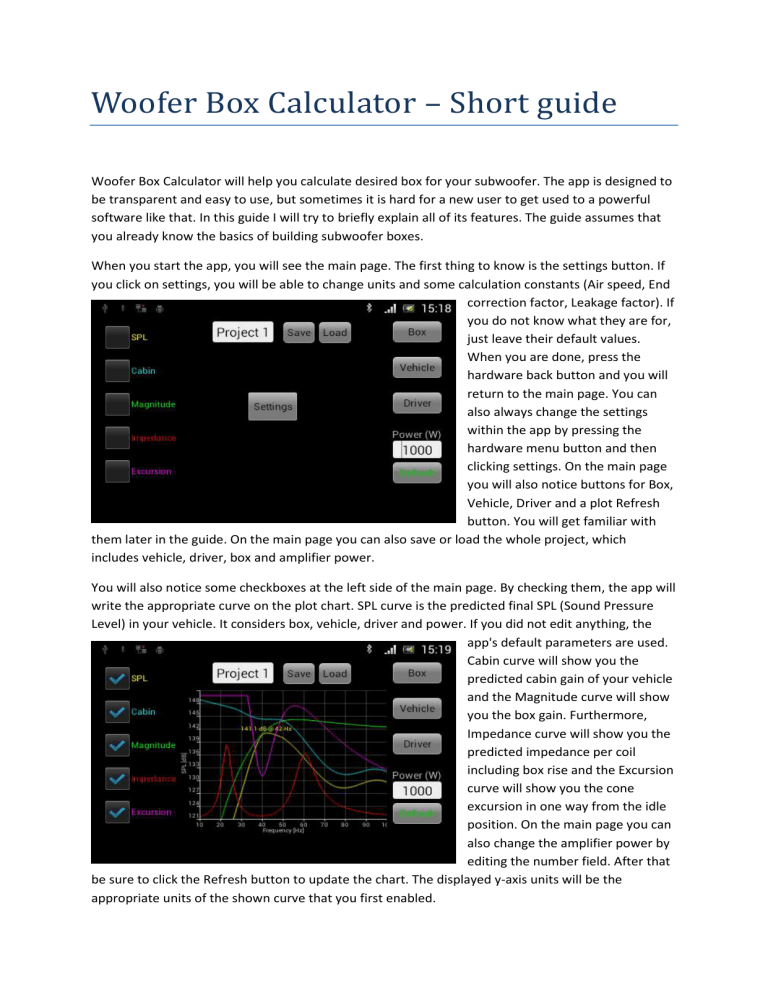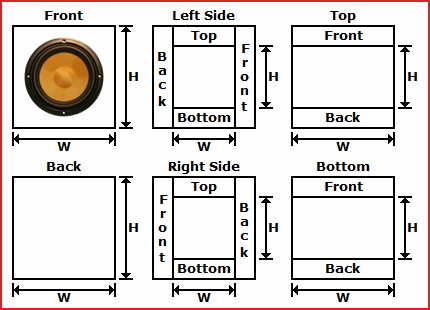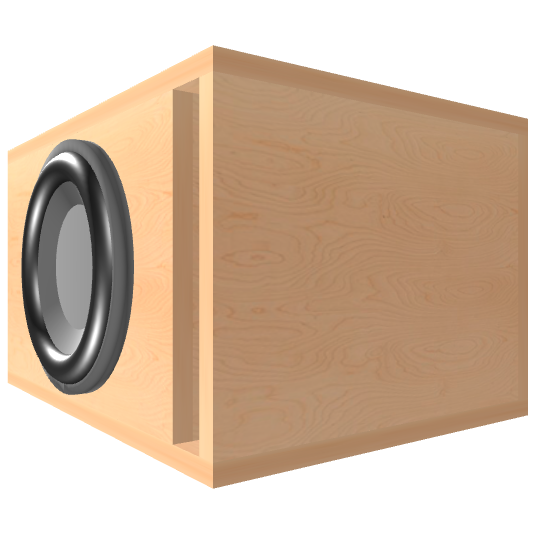An enclosure design software is supposed to help a designer calculate the optimum dimensions of the predefined geometry of a speaker cabinet. Such a geometry includes the box and the ports -if any- as well. The optimum amount of sound absorbing material is also expected to be determined.
Ideally such a software should evaluate the SPL response of the bass drivers and the ports -if any- at a nearby reference point (usually on tweeter axis at 1m) for a frequency range of 20 to 1000Hz. These responses should be as accurate as possible. For this they should include the following effects:
Other free software available on this site. Boxnotes - check your enclosure design for resonances. Print your cutting list Flare-it, - find the correct port flare size to avoid audible turbulence Subsaver - calculator for finding component values for a 2nd-order high-pass filter QRDude - calculator. Get help for the Speaker Volume Calculator Use the Speaker Box Designer to determine the correct Speaker Box Volume for Your Driver Use the Driver Displacement. Subwoofer box design online software. Subwoofer box calculator online. The calculation of sealed, bass-reflex, bandpass boxes by Thiele-Small parameters. Easy and convenient build your box. Dec 21, 2019 Speaker Box Lite may be the final entry on our best subwoofer and speaker design software list, but that doesn’t mean it’s less capable than any other tool. On the contrary, it packs several features that competitor products can get green with envy about, including an evergrowing database of devices (speakers), a graph drawing component.
a) edge diffraction step,
b) mutual coupling between bass drivers and ports,

c) the formation of standing wave modes within the enclosure and
d) the presence of sound absorbing material.

Factors a,c and d have a strong impact and can't be neglected. Most software implementations available today (ie. early 2015) are only an online computation of simple Thiele-Small-Margolis equations of the late seventies at which none of these factors was accounted for.
T Line Subwoofer Box Calculator Software
If we use these simplified equations as a reference for the computation of SPL responses, it is worth noting that:

a) Edge diffraction adds an 'error' of 3 to 6 dB over the range of 600 to 20Hz in an approximately uniform and definitely slowly changing manner. It is therefore not a good idea to neglect this factor. Algorithms that evaluate it are slow and rather big for online implementation. They need all external enclosure dimensions and exact driver/port locations. A program that doesn't ask for or use default values for these parameters simply doesn't account for baffle diffraction step.
b) Mutual coupling between any possible pair of bass sources (either woofer driver or port) creates a small and slowly varying 'error' response with respect to conventional Thiele-Small-Margolis computation, mainly below 120Hz and with a rather small dB amplitude (less than 1dB). It can be neglected in single woofer speakers or double-woofer speakers with woofer diameter less than 8'. Again algorithms that evaluate it are slow and rather big for online implementation. They need exact driver/port locations. A program that doesn't ask for or use default values for these parameters simply doesn't account for mutual coupling.
c) Standing waves formed within the volume of a speaker's cabinet create their own SPL response full of narrow-in-frequency peaks and dips, usually in the range of 100-1500Hz. These narrow dB 'spikes' cause rather minor perturbations to all woofer driver SPL responses because they are actually damped by cabinet (wooden) walls and/or sound absorbing material -if present. However a very strong version of these peaks and dips invades port (vent) radiation and its associated SPL response. Peaks are perceived as annoying whistling noises emitted by speaker ports and easily detected by listeners especially when the reproduced signal includes female vocals.
Displacing drivers and/or vents by a few centimeters or changing cabinet height can effectively suppress these unwanted vent emissions and produce what we call an 'optimised design'. Unfortunately algorithms that incorporate the standing-wave approach are extremely CPU-intensive and therefore unsuitable for online implementation. They need interior cabinet dimensions, driver/port locations on the baffle and cabinet wood material data. Thus a program that doesn't ask for or use default values for these parameters simply doesn't account for standing-wave modes.
d) Sound propagation in absorbing materials within a speaker enclosure:
1) shifts the shape of conventional Thiele-Small-Margolis SPL responses in frequency,
2) shifts standing-wave peaks and dips in frequency and
3) suppresses their dB amplitude.
Such algorithms directly associate to standing-wave computation and ask for several parameters such as absorbing material type, quantity, placement etc. Thus a program that doesn't ask for or use default values for these parameters simply doesn't account for the presence of sound absorbing material.
Using all these guidelines can definitely help us predict whether a piece of software is expected to provide a high degree of accuracy.

Car Speaker Box Plans
Subwoofer Box Design Software Winisd
There are quite a few different enclosure design software programs out there. The prices range from free to $1,000+. For most designs that the novice box builder will attempt there are a few I could recommend:
WinISD - WinISD is made available by LinearTeam. It's a very highly rated, free program for Windows. There is also an online version which isn't as full featured but can be run on any operating system through a web browser. This can be helpful for Mac/Apple users since MacSpeakerz has been discontinued.
Blaubox (click to download) - Blaubox has been around forever it seems. Created by Blaupunkt, it's a DOS program which may cause some run problems with the newest 64bit versions of Windows (try running it in 'compatibility mode'). It's free and definitely worth checking out. It even prints out the cut sheets for your car subwoofer box plans. If you still have trouble running it in compatability mode I'd recommend using a DOS emulator such as DOSBox. It's free and relatively uncomplicated to use.
DISCONTINUED MacSpeakerz - For the Macintosh users without a PC emulator there is a program out called MacSpeakerz. I haven't used it personally but it's fairly popular and virtually the only program made for the Mac. Provided by TrueAudio DISCONTINUED
Subwoofer Box Design Software For Mac
You should also check out Advanced Enclosure Design and Fabrication. It covers designing enclosures using free computer software, maximizing the output of a subwoofer system, building the box like a pro and testing the output using inexpensive equipment. Click here.
Speaker Box Calculator Software
Now that you've seen what's available let's take a look at some of the subwoofer enclosure plans I've created using the software.